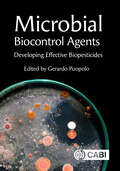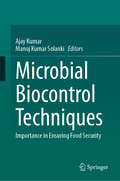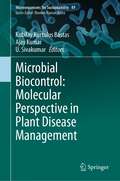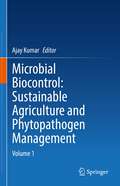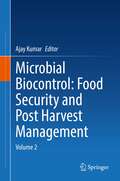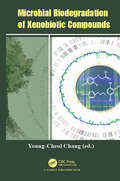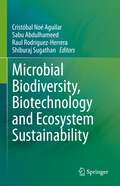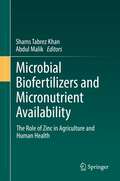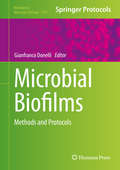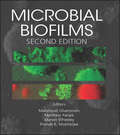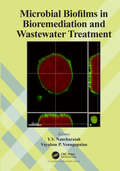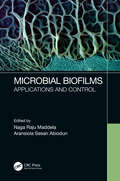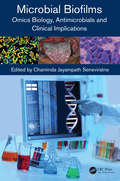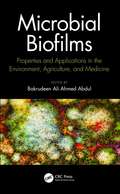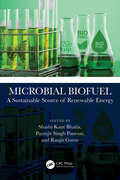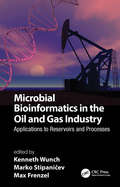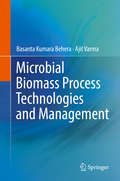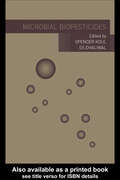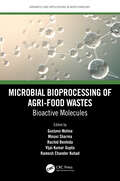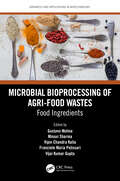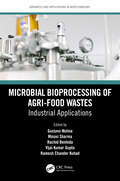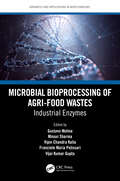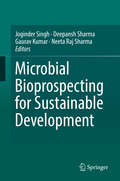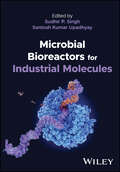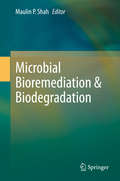- Table View
- List View
Microbial Biocontrol Agents: Developing Effective Biopesticides
by Vittorio Rossi Bernard R. Glick Laure Weisskopf Antonieta De Cal Paloma Melgarejo Marc Bardin Abhishek Anand Ana Bejarano Elisa Bona Tito Caffi Hamza Chammem Margherita Furiosi Elisa Gamalero Belén Guijarro Lars Huber Dr Ajay Kumar Inmaculada Larena Sara E. Legler Carla S. Lorenz Hassan Momeni Fahimeh Nazari Andrea Nesler Philippe Nicot Ma. del Orozco-Mosquedab Ilaria Pertot Thomas Pressecq Dr Gerardo Puopolo Naser Safaie Gustavo Santoyo Selena Tomada Estelle Turc Maria Villarino Mout De VriezeThe negative impact of chemical pesticides on human wellbeing and the environment has encouraged the development of eco-friendly alternatives for the management of plant pathogens. However, only a small number of microbial biocontrol agents (mBCAs) have been developed, registered and used in the management of plant diseases. This book analyses the deployment of mBCAs for the development of novel microbial biopesticides, considering the main plant-beneficial traits, procedures needed for effective formulations and the processes used for their validation. To guide the readers through the world of microbial biopesticides, the book starts with a chapter dedicated to the regulations that need to be followed for the development of final products. Readers will understand the importance of formulation and mode of action of mBCAs in developing microbial biopesticides. They will become familiar with key mBCAs such as Ampelomyces quisqualis, Bacillus spp., Trichoderma spp., and Pseudomonas spp., understanding the importance of formulation for their application in the field. This book explains the use of mBCAs to control post-harvest diseases and the potential of endophytic microorganisms as next-generation microbial biopesticides. A final chapter provides a useful workflow for the selection of new mBCAs and describes microbial species including promising mBCAs that might be developed as new microbial biopesticides. - Gives useful insights into the practicalities of regulation of mBCAs - Describes the underlying biology that it is critical to developing mBCAs - Provides case studies for key mBCA species - Indicates microbial species exploitable for the development of new microbial biopesticides For students and researchers involved in crop protection and biological control
Microbial Biocontrol Techniques: Importance in Ensuring Food Security (Microorganisms for Sustainability #54)
by Ajay Kumar Manoj Kumar SolankiThis book delves deeply into the field of microbial biological control. It is the method in which microbes, predators, and pathogens interact in a complex action to defend crops from damaging pests and diseases. This conventional method, which is frequently eclipsed by modern substitutes, is a cornerstone of sustainable agriculture. In addition to providing a practical way to protect our crops, it also offers a way to preserve the delicate ecosystems' balance while being environmentally benign. This book investigates the use of microbes in sustainable agriculture. It discusses current research and collaborations using helpful bacteria, emphasizing relationships between allies and foes. For disease resistance, emerging technologies like CRISPR/Cas9 and nanotechnology are considered. Market demands for biofertilizers that increase nutritional content and act as eco-friendly insecticides are discussed. Metagenomics, efficient formulations, and soil amendments are amongthe contemporary tools investigated. The volume strongly emphasizes shelf-life extension, biocontrol future trends, and storage, opening the door for creative microbial-based agricultural technologies. This interdisciplinary book is useful for a diverse group of readers including microbiologists, biotechnologists, agronomist, policymakers, university students and those who are interested in the development of strategies for sustainable farming by utilizing microbial communities.
Microbial Biocontrol: Molecular Perspective in Plant Disease Management (Microorganisms for Sustainability #49)
by Ajay Kumar Kubilay Kurtulus Bastas U. SivakumarThis book is exploring molecular insight of plant disease resistance, enhancing plant immunity as well as the latest omics or approaches in plant disease management. In the recent past, microbial strains or products frequently utilized to inhibit the growth of phytopathogen and disease management. However, it is well known that plants respond to numerous biotic and abiotic stresses by morphological, biochemical, and molecular mechanisms. But still there is much more to study about their molecular aspect of interaction between host- pathogens- biocontrol agents that will be helpful in formulation and applications of microbial antagonistic for effective management of phytopathogens. This book attempt to fill this gap in the literature. This book is of interest to teachers, researchers, agronomist, horticulturalist scientists, capacity builders and policymakers. Also the book serves as additional reading material for undergraduate and graduate students of agriculture, microbiology, environment science.
Microbial Biocontrol: Volume 1
by Ajay KumarThis first volume of a two-volume work presents the manifold applications of beneficial microbes and microbiomes in plant growth promotion, in enhancing crop resilience and in control of phytopathogens through microbial antagonists. In-depth insights into latest technologies such as biopriming of seeds and soil inoculation of rhizosphere microorganisms are provided.The two-volume work “Microbial Biocontrol” introduces mechanisms of plant-microbe interactions and explores latest strategies of how microbes can be applied in biocontrol and management of plant pathogens, replacing chemical fertilizers and pesticides. The book covers different groups of microorganisms such as bacteria, fungi, but also the interplay of entire microbiomes, and reviews their specific benefits in crop growth promotion, in enhancing the plants’ tolerance against biotic and abiotic stress as well as in post-harvest management of various plant diseases. Novel tools such as CRISPR/Cas9 and microbe derived nanoparticles are also addressed besides the legal aspects of biocontrol applications.Today, rising global population and changing climatic conditions emerge as a major challenge for agronomist farmers and researchers in fulfilling the requirements of global food production. The conventional agricultural practices utilize undistributed use of chemical fertilizers and pesticides to enhance growth and yield of agricultural products and fresh foods, but their extensive and continuous use have led to a range of negative consequences on the food quality and safety, to environment as well as to human and animal health. Microbial biocontrol applications are presented as a solution, paving the way to a sustainable agriculture in compliance with the UN Sustainable Development Goals (SDG). The book addresses researchers in academia and agriculture.
Microbial Biocontrol: Volume 2
by Ajay KumarThis second volume of a two-volume work reviews beneficial bioactive compounds from various microorganisms such as bacteria, fungi, cyanobacteria in plant diseases management and the postharvest management of fruits using microbial antagonists. Furthermore, it reviews the impact of climate change on food security and addressed the legal aspects of microbial biocontrol applications. The two-volume work “Microbial Biocontrol” introduces to mechanisms of plant-microbe interactions and explores latest strategies of how microbes can be applied in biocontrol and management of plant pathogens, replacing chemical fertilizers and pesticides. The book covers different groups of microorganisms such as bacteria, fungi, but also the interplay of entire microbiomes, and reviews their specific benefits in crop growth promotion, in enhancing the plants’ tolerance against biotic and abiotic stress as well as in post-harvest management of various plant diseases. Novel tools such as CRISPR/Cas9 and microbe derived nanoparticles are also addressed besides the legal aspects of biocontrol applications. Today, rising global population and changing climatic conditions emerge as a major challenge for agronomist farmers and researchers in fulfilling the requirements of global food production. The conventional agricultural practices utilize undistributed use of chemical fertilizers and pesticides to enhance growth and yield of agricultural products and fresh foods, but their extensive and continuous use have led to a range of negative consequences on the food quality and safety, to environment as well as to human and animal health. Microbial biocontrol applications are presented as a solution, paving the way to a sustainable agriculture in compliance with the UN Sustainable Development Goals (SDG). The book addresses researchers in academia and agriculture.
Microbial Biodegradation of Xenobiotic Compounds
by Young-Cheol ChangMicrobial Biodegradation of Xenobiotic Compounds examines and collects the recent information on the bioremediation technologies around the world. This book focuses on methods to decrease pollutants created by anthropogenic activities, industrial activities, and agricultural activities. This book answers some of the questions about – how to reduce contaminants? And whether there is a possibility of converting these pollutants in to useful energy by advanced biotechnological methods? The book combines present obtainable data with the expert knowledge of researchers from all over the world covering different aspects of environmental biotechnology and microbiology. It covers basic concepts of bioremediation and various methods involved in the bioremediation process, and provides specific chapters on the role of different genes and enzymes involved in microbial bioremediation process. It also gives special attention to heavy metal bioremediation by microalgae and the mechanisms involved during the degradation process. Recent innovative technologies about converting toxic pollutants in to useful energy like bioplastics and electricity are also discussed by specialist authors. Various chapters address the bioremediation of pesticides in soil using microbial metabolites, and molecular aspects of biodegradation which cover topics including identification of novel genes through the metagenomic approach and bioremediation using fungal laccase enzymes.
Microbial Biodiversity, Biotechnology and Ecosystem Sustainability
by Sabu Abdulhameed Shiburaj Sugathan Cristóbal Noé Aguilar Raul Rodriguez-HerreraThis book gives insight into several aspects of the microbiology, biotechnology, and ecosystem sustainability of special and under-explored regions, that captivate human beings by their natural richness, their extensive biodiversity, the extraordinary forms of adaptation of the living beings that they inhabit, and even that keep living secrets as is the very origin of life. The chapters emphasize all aspects of biological diversity-its description, analysis, and conservation, and its controlled rational use by humankind. Also, the book is elaborated from a wide and multidisciplinary point of view. It presents reviews, research papers, comments, and research notes on biodiversity, ethnobiology, geoscience, chemistry, biological conservation, biotechnology, and ecosystem sustainability Two hotspots are the reference for this enriching book that describes details of extraordinary areas of the planet, from Cuatrociénegas, Coahuila (Mexico) to the Southern Western Ghats (India). The book will contribute to dealing with the practicalities of conservation management, economic, social, and political issues. It provides a forum for examining conflicts between sustainable development and human dependence on biodiversity in agriculture, environmental management, and biotechnology, and encourages contributions from developing countries to promote broad global perspectives on matters of biodiversity and conservation.
Microbial Biofertilizers and Micronutrient Availability: The Role of Zinc in Agriculture and Human Health
by Abdul Malik Shams Tabrez KhanThis volume addresses various issues related to micronutrient deficiency, especially zinc, and discusses the possible approaches for combating mineral deficiency among humans and plants. The book mainly focuses on the zinc biofortification of vegetable and cereal crops and highlights the consequences of zinc deficiency and the health risks associated with zinc deficiency, especially in children and expecting mothers. The authors discuss different types of food that are rich in zinc and other minerals, how diets can be designed to meet the daily zinc requirements, and the impact of zinc deficiency on plant health and quality of agricultural products and the role of micronutrients in abiotic stress tolerance. The book also covers sustainable approaches to zinc biofortification in crops, such as the microbial solubilization of zinc in soil to improve zinc uptake by plants, and the formulation of these microbes into biofertilizers. The book will be of interest to dieticians, agricultural scientists, students and microbiologists.
Microbial Biofilms
by Gianfranco Donelli"The discovery that most of the chronic infections in humans, including the oral, lung, vaginal and foreign body-associated infections, are biofilm-based, has prompted the need to design new and properly focused preventive and therapeutic strategies for these diseases. Microbial Biofilms: Methods and Protocols provides a detailed description of the currently available methods and protocols to investigate bacterial and fungal biofilms, exhaustively illustrated and critically annotated in 25 chapters written by authors well known for their experience in the respective fields. The book has joined together microbiologists and specialists in infectious diseases, hygiene and public health involved in exploring different aspects of microbial biofilms as well as in designing new methods and/or developing innovative laboratory protocols. Written in the successful Methods in Molecular Biology series format, chapters include introductions to their respective topics, lists of the necessary materials and reagents, step-by-step, readily reproducible protocols, and notes on troubleshooting and avoiding known pitfalls. Authoritative and easily accessible, Microbial Biofilms: Methods and Protocols presents readers with the most established and validated experimental procedures to investigate microbial biofilms"--
Microbial Biofilms (ASM Books #48)
by Mahmoud Ghannoum Matthew Parsek Marvin Whiteley Pranab K. MukherjeeAn examination of the research and translational application to prevent and treat biofilm-associated diseases In the decade since the first edition of Microbial Biofilms was published, the interest in this field has expanded, spurring breakthrough research that has advanced the treatment of biofilm-associated diseases. This second edition takes the reader on an exciting, extensive review of bacterial and fungal biofilms, ranging from basic molecular interactions to innovative therapies, with particular emphasis on the division of labor in biofilms, new approaches to combat the threat of microbial biofilms, and how biofilms evade the host defense. Chapters written by established investigators cover recent findings, and contributions from investigators new to the field provide unique and fresh insights. Specifically, Microbial Biofilms provides state-of-the-art research in the field of bacterial and fungal biofilms detailed descriptions of the in vitro and in vivo models available to evaluate microbial biofilms future areas of research and their translational and clinical applications Microbial Biofilms is a useful reference for researchers and clinicians. It will also provide insight in the dynamic field of microbial biofilms for graduate and postgraduate students.
Microbial Biofilms in Bioremediation and Wastewater Treatment
by Vayalam P. Venugopalan Y. V. NancharaiahBiofilms represent the natural living style of microbial communities and play a pivotal role in biogeochemical cycles and natural attenuation. Biofilms can be engineered for biodegradation and biotransformation of organic and inorganic contaminants, for both in situ bioremediation and ex situ treatment in bioreactors. This book focuses on microbial biofilms and their potential technological applications for sustainable development. It covers recent advances in biofilm technologies for contaminant remediation coupled to recovery of resources and serves as a complete reference on the science and technology behind biofilm mediated bioremediation and wastewater treatment.
Microbial Biofilms: Applications and Control
by Naga Raju Maddela Aransiola Sesan AbiodunMicrobial biofilms have both positive and negative effects. This book considers new ways of controlling environmental microbial biofilm such as using phages, nanotechnology, and newly discovered microbial enzymes. A team of contributors shares current, relevant and original research to add weight and recognition to the book. Also, each chapter provides enlightening and relevant tabular information, charts, and illustrations. The book is, therefore, informative, precise, useful and easily digested by users.
Microbial Biofilms: Omics Biology, Antimicrobials and Clinical Implications
by Chaminda Jayampath SeneviratneMicrobial Biofilms: Omics Biology, Antimicrobials and Clinical Implications is a comprehensive survey of microbial biofilms and their role in human health and disease with contributions from world renowned experts in molecular microbiology, proteomics, genomics, metabolomics and infectious diseases. The book is intended to serve as a guide for students, as well as a reference for researchers, clinicians and industry professionals. <P><P>The chapters cover bacterial and fungal microbiomes, and the latest omics techniques organized in a clear and up-to-date manner. One of the highlights of this book is the comprehensive information on "omics of microbial biofilms". The chapters dedicated to metagenomics, proteomics and metabolomics are designed to provide a simple and holistic review of the current knowledge and, the applications of these techniques in the field of microbial biofilms. In addition to introductory chapters on microbial biofilms and their clinical implications, subsequent chapters delve into oral biofilms, their composition, and metagenomic diversity. Thereafter, mechanisms of drug resistance in microbial biofilms are reviewed, as well as the proteomic and metabolomic characterization of this resistance. The book includes a comprehensive discussion of persister cells and host–microbial interactions on mucosal surfaces. Finally, the book concludes with a summary of novel therapeutic approaches for biofilms such as synbiotics and biogenics.
Microbial Biofilms: Properties and Applications in the Environment, Agriculture, and Medicine
by Bakrudeen Ali Ahmed AbdulThis book provides a broad range of applications and recent advances in the search for biofilm materials in nature. It also explains the future implications for biofilms in the areas of advanced molecular genetics, pharmaceuticals, pharmacology, and toxicology. This book is comprised of 20 chapters from leading experts in the field and it examines immunology and microbiological studies derived from biofilms as well as explores environmental, agricultural, and chemical impacts on biofilms. It is divided into five subdivisions: biofilms and its complications, biofilm infections in human body, detection of biofilm-forming pathogens, antibiofilm chemotherapy, and biofilms production tools in aquaculture. This book may be used as a text or reference for everyone interested in microbial biofilms and their current applications. It is also highly recommended for environmental microbiologists, medical microbiologists, bioremediation experts, and microbiologists working in biocorrosion, biofouling, biodegradation, water microbiology, quorum sensing, and many other related areas. Scientists in academia, research laboratories, and industry will also find it of interest. This book includes chapter homework problems and case studies. Powerpoints are also available for adopting instructors. Discusses and clarifies the resource of isolation and chemical properties from biofilms Discusses the latest pharmaceutical, pharmacological, and medicinal approaches toward the treatment of chronic and uncured diseases, such as Alzheimer’s osteoporotic, sexual dysfunction, sleep sickness, allergy treatment, asthma, hair loss, AIDS, hypertension, antiaging, etc. Examines immunology and microbiological studies derived from biofilms Explores environmental, agricultural, and chemical impacts on biofilms. Dr. Bakrudeen Ali Ahmed Abdul is an Associate Professor, the Head of the Department of Biochemistry and Dean of the School of Life Sciences, Centre for Research and Development (CRD), PRIST Deemed University, Vallam, Thanjavur, Tamil Nadu, India. His research areas include the application of plant biochemistry, bioactive compound production, biotechnological methods, development of pharmaceutical products and pharmacological studies.
Microbial Biofuel: A Sustainable Source of Renewable Energy
by Shashi Kant Bhatia Parmjit Singh Panesar Ranjit GuravMicrobial Biofuel: A Sustainable Source of Renewable Energy explores microbial biofuel production from a technical standpoint addressing a wide range of topics including bio alcohol, biodiesel, biohydrogen, biomethane, biohythane, jet fuel, drop-in fuel, bioelectricity, bio-oil, biomass to biofuel, carbon capture, and more.Each chapter provides an in-depth examination of a specific biofuel type, discussing the underlying science, production processes, challenges, and its potential applications. The title draws examples from the latest research and advancements in the field, including cutting-edge technologies, methodologies, and case studies. It covers advances in fermentation strategies and commercial-scale implementation of microbial technology for biofuel production along with comprehensive information on bio alcohol, biodiesel, biohydrogen, biomethane, etc. The book explores practical applications of microbial biofuels and uses real-life examples and case studies. Moreover, the book discusses sustainability and environmental benefits of using renewable energy.The title is an ideal read for graduate students and researchers specialising in bioenergy and chemical engineering.
Microbial Bioinformatics in the Oil and Gas Industry: Applications to Reservoirs and Processes (Microbes, Materials, and the Engineered Environment)
by Kenneth Wunch Max Frenzel Marko StipanicevThis book brings together contributions from leading scientists, academics, and experts from the oil and gas industry to discuss microbial-related problems faced by the industry and how bioinformatics and an interdisciplinary scientific approach can address these challenges. Microbial Bioinformatics in the Oil and Gas Industry: Applications to Reservoirs and Processes presents the major industrial problems caused by microbes (e.g., souring, biocorrosion) as well as the beneficial activities (e.g., biofuels, bioremediation). FEATURES Offers a detailed description of how bioinformatics has advanced our understanding of numerous issues in the oil and gas industry Covers cases from geographically diverse oil fields, laboratories, and research groups Contains fundamentals and applied information of relevance to the oil and gas sector Presents contributions from a team of international experts across industry and academia With its cross-disciplinary approach, this comprehensive book provides microbial ecologists, molecular biologists, operators, engineers, chemists, and academics involved in the sector with an improved understanding of the significance of microbial bioinformatics applications in the oil and gas industry.
Microbial Biomass Process Technologies and Management
by Ajit Varma Basanta Kumara BeheraThis book describes how microbes can be used as effective and sustainable resources to meet the current challenge of finding suitable and economical solutions for biopharmaceuticals, enzymes, food additives, nutraceuticals, value added biochemicals and microbial fuels, and discusses various aspects of microbial regulatory activity and its applications. It particularly focuses on the design, layout and other relevant issues in industrial microbe applications. Moreover, it discusses the entire microbial-product supply chain, from manufacturing sites to end users, both in domestic and international markets, providing insights into the global marketing of microbes and microbial biomass-derived products. Further, it includes topics concerning the effective production and utilization of eco-friendly biotechnology industries. It offers a valuable, ready-to-use guide for technologists and policymakers developing new biotechnologies.
Microbial Biopesticides
by Opender Koul G. S. DhaliwalBiotechnological research has provided key developments in pest control agents, focusing on pathogens of insect pests as formulated biological pesticides. Emphasis has been placed on bacteria and viruses as they are well understood and easily manipulated. Microbial Biopesticides provides a comprehensive overview of the advances made in the use of bacteria, fungi, and viruses, while focusing on behavioral, chemical, and molecular aspects. The authors discuss the potential of nematode-based biochemical agents and bioherbicides and explore the role of microbial biopesticides in integrated pest management and their prospects for commercial exploitation.
Microbial Bioprocessing of Agri-food Wastes: Bioactive Molecules (Advances and Applications in Biotechnology)
by Vijai Kumar Gupta Gustavo Molina Ramesh Chander Kuhad Minaxi Sharma Rachid BenhidaThis book gives a comprehensive overview of recent advances in the valorization of agri-food waste and discusses the main process conditions needed to overcome the difficulties of using waste as alternative raw materials. It also discusses specific methodologies, opportunistic microbes for biomass valorization, the sustainable production of agri-food waste, as well as examines the assessment and management of bioactive molecules production from microbial-valorization of agri-food waste. The authors provide technical concepts on the production of various bio-products and their commercial interest including agri-food waste utilization in the microbial synthesis of proteins, the valorization of horticulture waste, the sustainable production of pectin via microbial fermentation, as well as other food and pharmacological applications. This book is intended for bioengineers, biologists, biochemists, biotechnologists, microbiologists, food technologists, enzymologists, and related professionals and researchers. Explores recent advances in the valorization of agri-food waste Provides technical concepts on the production of various bio-products of commercial interest Discusses the main process conditions to overcome the difficulties of using waste as alternative raw materials Introduces technical-economic details on the advantages and disadvantages of exploring the waste recovery chain Explores the main technological advances in the recovery of residues in functional products
Microbial Bioprocessing of Agri-food Wastes: Food Ingredients (Advances and Applications in Biotechnology)
by Vijai Kumar Gupta Gustavo Molina Vipin Chandra Kalia Franciele Maria Pelissari Minaxi SharmaFood ingredients are important molecules of the most diverse chemical classes responsible for conferring nutrition, stability, color, flavor, rheological and sensorial characteristics, in addition to several other important uses in the food industry. In this way, the production routes of these ingredients have gained more and more attention from consumers and producing industries, who expect that, in addition to their technological properties, these ingredients are still obtained without synthetic means, with savings of natural resources and mainly with less environmental impact. This book is intended for bioengineers, biologists, biochemists, biotechnologists, microbiologists, food technologists, enzymologists, and related professionals/ researchers. • Explores recent advances in the valorization of agri-food waste into food ingredients • Provides technical concepts on the production of various food ingredients of commercial interest• Explores novel technologically advanced strategies for the extraction of bioactive compounds from food wastes• Presents important classes of food ingredients obtained from alternative raw materials• Presents sustainable food waste resources and management strategies• Presents different pretreatment technologies and green extraction methodologies to support a green environment in the circular economy concept.• Challenges in applications of re-derived bioactive compounds from food wastes in food formulations
Microbial Bioprocessing of Agri-food Wastes: Industrial Applications (Advances and Applications in Biotechnology)
by Vijai Kumar Gupta Gustavo Molina Ramesh Chander Kuhad Minaxi Sharma Rachid BenhidaMicrobes are widely used in large-scale industrial processes due to their versatility, easy growing cultivation, kinetic potential, and the ability to generate metabolites with a wide range of potential applications to various commercial sectors, such as the food, pharmaceutical and cosmetic industries, in addition to the potential for agriculture, biomedical, and several others. Among the metabolites of greatest commercial interest, and many obtained on an industrial scale, the wide range of enzymes, biofuels, organic acids, amino acids, vitamins, biopolymers, and many other classes of metabolites. This book is intended for Bioengineers, Biologist, Biochemist, Biotechnologists, microbiologist, food technologist, enzymologist, and related Professionals/ researchers. Explores recent advances in the valorization of agri-food waste Provides technical concepts on the production of various bio-products of commercial interest Discusses the main process conditions to overcome the difficulties of using waste as alternative raw materials Introduces technical-economic details on the advantages and disadvantages of exploring the waste recovery chain Explores the main technological advances in the recovery of residues in functional products
Microbial Bioprocessing of Agri-food Wastes: Industrial Enzymes (Advances and Applications in Biotechnology)
by Vijai Kumar Gupta Gustavo Molina Vipin Chandra Kalia Franciele Maria Pelissari Minaxi SharmaEnzymes are biological molecules of great relevance. In addition to the fundamental role in metabolic reactions, they have diverse applications in industrial processes in generating products of great commercial utility for the most diverse areas. Thus, industries seek to expand research to select microorganisms capable of producing enzymes according to their commercial objectives. Considering the diversity of the microbiota kingdom, as well as the diversity of mode of action of different classes of enzymes, this is an area that deserves constant investments to elucidate new applications, considering that these biological catalysts have great selectivity and a diversity of mode of action, reusable, and operate under mild process conditions, becoming the bridge for the development of sustainable processes and for adding value to commercial products. This book is intended for bioengineers, biologists, biochemists, biotechnologists, microbiologists, food technologists, enzymologists, and related professionals/ researchers.• Explores recent advances in the valorization of agri-food waste into enzymes • Explores the main technological advances in the recovery of residues and their use for the production of enzymes• Provides technical concepts on the production of various enzymes of commercial interest • Presents the main classes of enzymes obtained from alternative raw materials.
Microbial Bioprospecting for Sustainable Development
by Deepansh Sharma Joginder Singh Gaurav Kumar Neeta Raj SharmaThis book presents a comprehensive overview of the use of microorganisms and microbial metabolites as a future sustainable basis of agricultural, environmental and industrial developments. It provides a holistic approach to the latest advances in the utilization of various microorganism bioprospecting including their wide range of applications, traditional uses, modern practices, and designing strategies to harness their potential. In addition, it highlights advanced microbial bioremediation approaches, including genetic manipulation, metagenomics analysis and bacteriophage-based sensors for the detection of food-borne pathogens. Lastly, it elaborates on the latest advances regarding the role of microbes in the sustainable development of various industrial products.
Microbial Bioreactors for Industrial Molecules
by Sudhir P. Singh Santosh Kumar UpadhyayMicrobial Bioreactors for Industrial Molecules Harness the planet’s most numerous resources with this comprehensive guide Microorganisms constitute the invisible majority of all living creatures on Earth. They are found virtually everywhere on the planet, including in environments too extreme for any larger organisms to exist. They form a hugely significant resource whose potential value for human society cannot be overlooked. The creation of microorganism- based bioreactors for the industrial production of valuable biomolecules has the potential to revolutionize a range of industries and fields. Microbial Bioreactors for Industrial Molecules provides a comprehensive introduction to these bioresources. It covers all potential approaches to the use of microbial technology and the production of high-value biomolecules for the pharmaceutical, cosmetic, and agricultural industries, among others. The book’s rigorous detail and global, holistic approach to harnessing the power of the planetary microbiome make it an invaluable introduction to this growing area of research and production. Readers will also find: Detailed coverage of basic, applied, biosynthetic, and translational approaches to the use of microbial technology Discussion of industrially produced microbe-borne enzymes including invertase, lipase, keratinase, protease, and more Approaches for using microbial bioreactors to generate biofuels Microbial Bioreactors for Industrial Molecules is essential for scientists and researchers in microbiology and biotechnology, as well as for professionals in the biotech industries and graduate students studying the applications of the life sciences.
Microbial Bioremediation & Biodegradation
by Maulin P. ShahMicrobial or biological degradation has long been the subject of active concern, and the rapid expansion and growing sophistication of various industries in the last century has significantly increased the volume and complexity of toxic residues of wastes. These can be remediated by plants and microbes, either natural origin or adapted for a specific purpose, in a process known as bioremediation. The interest in microbial biodegradation of pollutants has intensified in recent years in an attempt to find sustainable ways to clean contaminated environments. These bioremediation and biotransformation methods take advantage of the tremendous microbial catabolic diversity to degrade, transform or accumulate a variety of compounds, such as hydrocarbons, polychlorinated biphenyls, polaromatic hydrocarbons pharmaceutical substances, radionuclides and metals. Unlike conventional methods, bioremediation does not physically disturb the site. This book describes the basic principles of biodegradation and shows how these principles are related to bioremediation. Authored by leading, international environmental microbiologists, it discusses topics such as aerobic biodegradation, microbial degradation of pollutants, and microbial community dynamics. It provides valuable insights into how biodegration processes work and can be utilised for pollution abatement, and as such appeals to researchers and postgraduate students as well as experts in the field of bioremediation.
